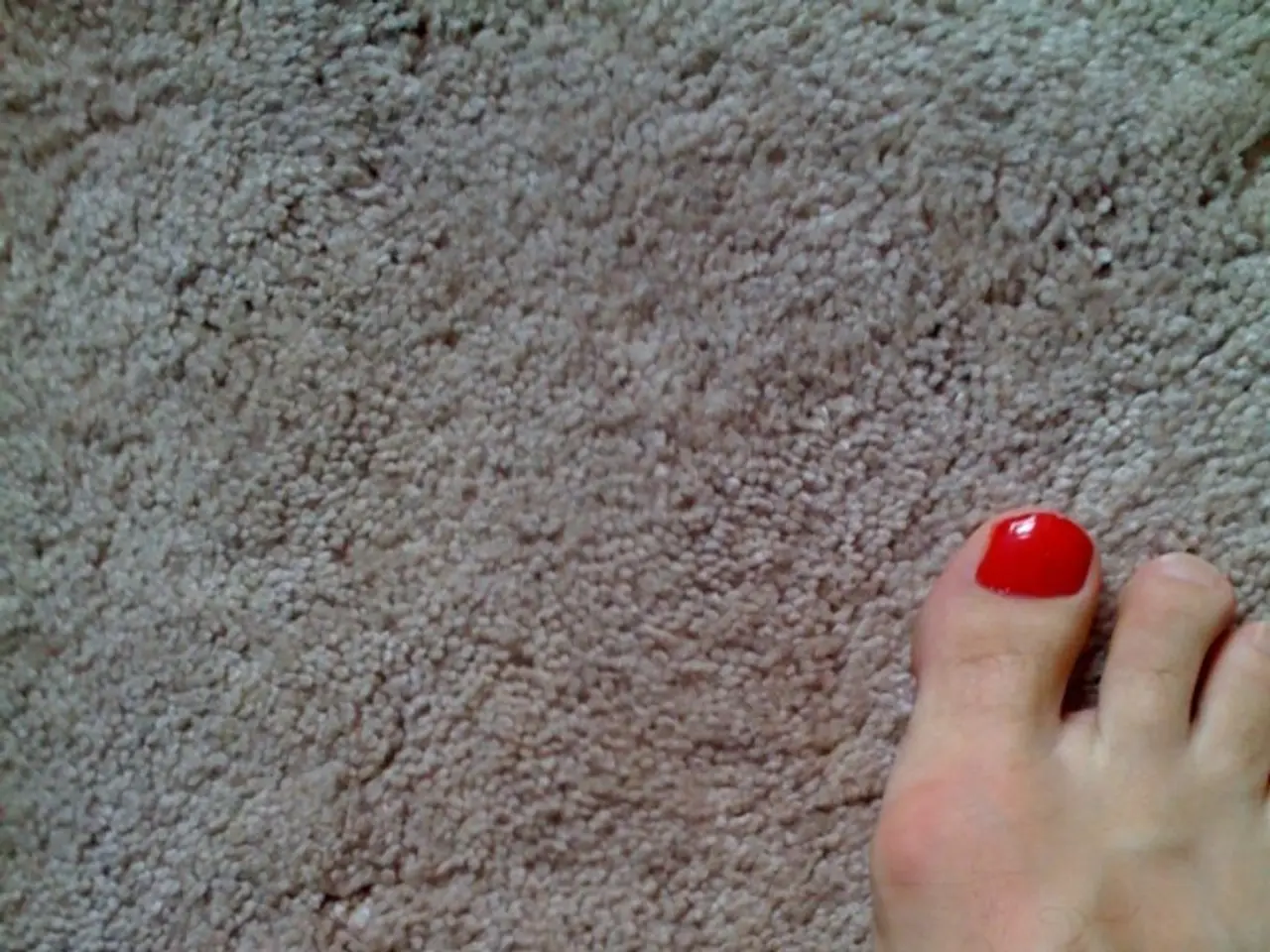Nail curvature: Understanding the reasons behind spoon nails and their bent tips and sides
Curved and ingrown toenails can sometimes indicate underlying health issues, although they are not always associated with systemic diseases. This article explores the causes, symptoms, and treatment options for these nail conditions.
Causes and Associated Conditions
Several factors can contribute to curved or ingrown nails. These include:
- Inherited Nail Shape and Genetics: Some individuals are genetically predisposed to have nails that naturally curve or are too large for their toe beds, increasing the risk of ingrown nails.
- Non-Infectious Skin Conditions: Chronic inflammation from conditions like psoriasis or eczema can make the skin around the nail fragile, increasing the likelihood of the nail growing into it.
- Fungal Infections: Fungal nail infections can cause thickening and abnormal curvature of the nail, potentially leading to ingrown nails.
- Trauma and Improper Nail Care: Injuries, improper trimming (cutting nails too short or rounding the corners too much), or repetitive pressure from ill-fitting footwear can cause or worsen both curved and ingrown nails.
- Diabetes and Circulation Issues: While curved nails are not a hallmark of diabetes, people with diabetes or poor circulation are at higher risk of complications if nail problems—such as infections—are not promptly treated.
Symptoms and Complications
Curved and ingrown nails can result in discomfort, redness, and swelling around the nail edge. If the nail pierces the skin, bacteria can enter, leading to infection marked by pus, warmth, throbbing, and sometimes bleeding. Infections can become serious if left untreated, potentially leading to cellulitis or even osteomyelitis (bone infection) in severe cases.
An ingrown nail occurs when the edge of the nail grows into the skin, causing pain, inflammation, and, if left untreated, infection. Persistent nail pressure or recurrent infections can lead to skin breakdown, particularly in those with diabetes or poor circulation.
Treatment Options
Home Care and Prevention
Proper nail care and footwear choices can help prevent and manage curved or ingrown nails. This includes:
- Proper Nail Trimming: Cut nails straight across with slightly rounded corners, avoiding cutting too short.
- Footwear: Wear shoes with a wide toe box and avoid tight or high-heeled shoes for extended periods.
- Moisturization: Keep feet moisturized to prevent brittle nails.
- Prompt Treatment of Infections: Address fungal or bacterial infections early with appropriate medications.
- Hygiene: Wash feet daily and keep nails clean to reduce the risk of infection.
Medical Treatment
If pain is persistent, there are signs of infection, or home care fails, it's essential to consult a podiatrist. Podiatrists can safely trim or remove the problematic nail edge, sometimes under local anesthetic. For recurrent or severe ingrown nails, a minor procedure such as partial nail avulsion (removal of part of the nail) may be performed, often with a chemical (phenol) to reduce recurrence.
If psoriasis, diabetes, or other systemic conditions are present, managing these can help reduce nail-related complications. If infection is present, oral or topical antibiotics may be prescribed.
When to Seek Urgent Care
Individuals should seek prompt medical attention if they experience signs of spreading infection, persistent symptoms, or have underlying health issues such as diabetes, circulatory problems, or immunosuppression.
Summary Table
| Condition/Effect | Causes | Symptoms | Treatment Options | |-----------------------------------------|------------------------------------------|-------------------------------------|------------------------------------------| | Ingrown nail | Curved nails, improper trimming, trauma | Pain, redness, swelling, infection | Proper trimming, footwear, surgery | | Infection (bacterial/fungal) | Skin penetration, poor hygiene | Pus, warmth, throbbing, bleeding | Antibiotics, surgical drainage | | Chronic skin conditions (psoriasis) | Inflammation, fragile skin | Recurrence, slow healing | Skin care, treat underlying disease | | Genetic predisposition | Inherited nail shape | Family history, recurrence | Surgical options, regular podiatric care |
Key Takeaway
Curved and ingrown toenails can be managed effectively with proper nail care and footwear, but persistent or infected cases require medical attention to prevent complications—especially in individuals with underlying health issues. Early intervention is crucial for comfort and to minimize the risk of serious infection.
- Genetics and inherited nail shape can make some individuals more susceptible to curved or ingrown nails.
- Chronic inflammation from conditions like psoriasis can lead to fragile skin around the nail, increasing the likelihood of ingrown nails.
- Fungal nail infections can cause abnormal curvature and thickening of the nail, potentially leading to ingrown nails.
- Injuries, improper nail trimming, or repetitive pressure from ill-fitting footwear can cause or worsen both curved and ingrown nails.
- Diabetes and poor circulation can increase the risk of complications if nail problems, such as infections, are not promptly treated.
- Curved and ingrown nails can result in discomfort, redness, and swelling around the nail edge.
- If the nail pierces the skin, bacteria can enter, leading to infection marked by pus, warmth, throbbing, and sometimes bleeding.
- Infections can become serious if left untreated, potentially leading to cellulitis or even osteomyelitis in severe cases.
- An ingrown nail occurs when the edge of the nail grows into the skin, causing pain, inflammation, and, if left untreated, infection.
- Persistent nail pressure or recurrent infections can lead to skin breakdown, particularly in those with diabetes or poor circulation.
- Proper nail care and footwear choices can help prevent and manage curved or ingrown nails.
- Cut nails straight across with slightly rounded corners, avoiding cutting too short.
- Wear shoes with a wide toe box and avoid tight or high-heeled shoes for extended periods.
- Keep feet moisturized to prevent brittle nails.
- Address fungal or bacterial infections early with appropriate medications.
- Wash feet daily and keep nails clean to reduce the risk of infection.
- If pain is persistent, there are signs of infection, or home care fails, consult a podiatrist.
- Podiatrists can trim or remove the problematic nail edge, sometimes under local anesthetic.
- A minor procedure such as partial nail avulsion may be performed to treat recurrent or severe ingrown nails.
- For underlying health issues like psoriasis, managing these conditions can help reduce nail-related complications.
- If infection is present, oral or topical antibiotics may be prescribed.
- Individuals should seek prompt medical attention if they experience signs of spreading infection, persistent symptoms, or have underlying health issues such as diabetes, circulatory problems, or immunosuppression.
- Invisible braces, also known as orthodontic aligners, can improve the appearance of curved or ingrown nails due to misalignment.
- Dermatitis, a common skin condition, can sometimes be aggravated by the use of certain nail products or weakened skin due to ingrown nails.
- Sclerosis, a group of diseases that affect the connective tissue, can sometimes cause nail changes, including curvature.
- Depression and anxiety can sometimes coexist with chronic nail conditions, leading to decreased self-care and worsening symptoms.
- Obesity can contribute to the development of ingrown nails, as it may exacerbate foot problems due to increased bodyweight.
- Atopic dermatitis, a chronic inflammatory skin disease, can cause patches of red, itchy skin around the nail bed, making it more susceptible to ingrown nails.
- Psoriasis, an autoimmune skin disorder, can cause thickened nails with pits or ridges, which may increase the risk of ingrown nails.
- AQ (aquagenic pruritus), a rare skin condition that causes itching upon contact with water, can exacerbate skin inflammation and increase the risk of ingrown nails.
- Multiple myeloma, a cancer of the plasma cells, can sometimes cause nail changes, including thickening or ridging, which can increase the risk of ingrown nails.
- Lymphoma, a cancer of the immune system, can sometimes cause enlarged lymph nodes, which can apply pressure to the toenails and cause ingrown nails.
- Mycosis fungoides, a type of cutaneous T-cell lymphoma, can cause skin changes around the nail bed, increasing the risk of ingrown nails and potential complications.





